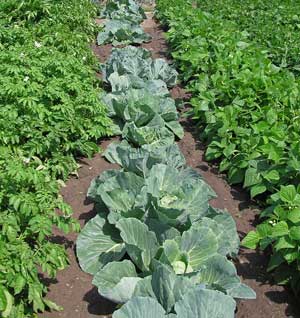If you grow edibles long enough, you're bound to run into some problems. Many these problems can be avoided (or at least overcome) with proper cultivation techniques. Unfortunately, once in a while problems crop up that are difficult to diagnose and not easily remedied. Whether one plant is having a problem, or a whole crop, here's a list of some common problems in the vegetable garden and what causes them.
General Crop Problems
Seed Not Germinating:
Caused by old seeds, washed away seeds, lack of moisture, temperatures being too cold or too hot, improper planting depth or seeds being stolen by animals.
Plants Lack Vigor (spindly seedlings):
Usually due to tired soil (lack of organic nutrients), lack of proper light, and root damage caused by disease or transplanting.
Low Yields:
This could be due to a lack of water, using the wrong type of fertilizer (fruiting crops like tomatoes and peppers like high amounts of potassium, while leaf plants like cabbage like high amounts of nitrogen), or plants may be too crowded and unable to compete for nutrients.
Generally Slow Growth:
This could be due to improper pH, infertile soil, cool weather, low light conditions, poor drainage (poor soil structure) or too little or too much moisture.
Unsteady Supply of Crops:
This is primarily due to a lack of succession planting. Stagger crops like carrots, lettuce and green beans a few weeks apart so you have a continuous supply all season long.
Pin Holes in Leaves:
The culprit here is usually the flea beetle, a small, black or silver insect that jumps when disturbed.
Standing Water:
This indicates a drainage problem caused by poor soil structure.
Crop Specific Problems
Artichokes
- They Are Taking Over: Shoots (or fragments of shoots) left over in the ground after harvesting will form new plants the following season.
Beans
- Failure to Develop Flowers: This is caused by elevated daytime temperatures (above 90ºF). The beans will usually resume flowering when temperatures drop.
- Failure to Form Pods: The failure to develop pods is usually caused by one of three reasons. The first is due to inadequate moisture levels (beans are a thirsty crop). The second happens when bees fail to pollinate the bean flowers while raiding them of nectar. White-flowered varieties seem less susceptible to this. A third reason is flower damage caused by birds-usually indicated by a pile of shredded flowers on the ground around the bean plant.
Carrots (radishes, etc.)
- Forked or Deformed Roots: Usually caused by erratic watering, applying too much manure close to planting time, inadequate thinning or compact, stony soil.
Corn
- Misshapen Ears or No Ears: This is usually due to improper pollination and happens when corn is planted in straight rows (instead of grids) or if corn is planted on an overly windy site.
Cucumbers
- Mottled or Spotty Leaves & Wilted Fruit: The likely culprit is either the result of cucumber mosaic virus, or sudden swings in temperature and soil moisture.
- Odd-shaped or Very Small Fruit: Caused by a lack of soil moisture, cool temperatures during development, or poor pollination due to a low numbers of bees and/or male flowers.
Eggplant
- Failure to Set Fruit (blossom-drop): This can be caused by too cool (below 60ºF) or too warm (above 75ºF) nighttime temperatures.
- Blossom-end Rot: Usually caused by dry soil due to a lack of irrigation or erratic watering.
Lettuce & Spinach (also onions)
- Bolting Early (going to seed): Caused by dry roots or low temperatures during certain stages of development. This can also happen during warm temperatures and long days. Early producing varieties are more susceptible to bolting.
Onions
- Smaller Than Expected Onions: Usually caused by over-crowding, or a lack of moisture.
- Onions Turn Soft During Storage: This is often happens after harvesting unripe fruits, failing to cure (dry ) the bulbs naturally before storage, or storing onions in poorly ventilated areas.
Peas
- Flowering Ceases: This usually happens naturally once warm summer temperatures arrive.
Peppers
- Failure to Set Fruit (blossom drop): This can be caused by too cool (below 60ºF) or too warm (above 75ºF) nighttime temperatures.
- Blossom-end Rot: This is usually a result of dry soil due to a lack of irrigation or erratic watering.
Potatoes
- Green (sunburned): Potatoes turn green with exposure to light. This is caused by a failure to cover them with soil while they develop.
Radishes
- Poor Root Development: The cause is usually warm temperatures. Roots develop best in cooler temperatures, while warmer temperatures tend to stimulate the growth of leaves.
Tomatoes
- Split Fruit: This happens as a result of watering after a period of being overly dry.
- Poor Growth & Small Fruit: Caused by using old, large or overly hardened transplants. Young transplants with 5-7 true leaves and just slightly hardened normally produce the best yields and fruit size.
- Blossom-end Rot: Usually caused by dry soil due to a lack of irrigation or erratic watering.
- Failure to Set Fruit (blossom drop): Often caused by too cool (below 60ºF) or too warm (above 75ºF) nighttime temperatures.
- Slow Growth: Usually a results of failing to harden off plants properly before transplanting-often seen with purple-tinted foliage. Slow growth can also be an indicator of root rot due to tomatoes being grown on the same site for several years.
Zucchini
- Turns Moldy: Usually caused by a fungus brought on by wet weather and further encouraged by over-head watering.
- White or "Felted-looking" Leaves: This is powdery mildew caused by wet conditions and poor air circulation around leaves.

